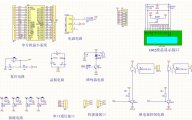基于51单片机的铸造车间环境监测系统设计

基于51单片机的铸造车间环境监测系统设计(任务书,开题报告,外文翻译,论文12000字)
摘要
经过了多年的发展,我国已经成为了世界公认的工业大国,在朝着工业强国的发展道路上,我国还有许多问题需要克服,应不断提升我国工业生产的自动化程度,提高我国工业生产的效率。工业生产离不开车间这个实际生产基地,好的产品更离不开车间良好的环境。本文的研究视角就集中在铸造车间的环境监测上,目的是设计一套对铸造车间湿度和温度进行监测控制的单片机系统,主要实现对铸造车间的湿度和温度监测,在铸造车间的湿度和温度超过一定的界限值后会进行报警,并启动风机对铸造车间降温降湿。本系统的设计主要采用仿真法先对铸造车间环境监测系统的功能进行模拟,然后再根据需求制作实物模拟铸造车间的环境对系统功能进行验证,力图为我国铸造车间的环境监测控制提供一定的实用性设计方案参考。
关键词:51单片机;环境监测;温度;湿度
Abstract
After years of development, China has become a recognized industrial power in the world. On the way to becoming an industrial power, China still has many problems to overcome, to constantly improve the degree of automation of China's industrial production, and to improve the efficiency of China's industrial production. Industrial production is inseparable from the workshop of the actual production base. Besides, a good product is inseparable from the workshop of a good environment. Research perspective of this article is focused on the environmental monitoring in the foundry, the purpose is to design a set of casting workshop humidity and temperature monitoring control of single chip microcomputer system, the main implementation of humidity and temperature monitoring in the foundry, the humidity and temperature in casting workshop after more than a certain threshold value will be carried out in alarm, and start the fan to foundry wet cooling down. The design of this system mainly uses the simulation method. Firstly, simulate the function of the environmental monitoring system of the casting workshop. Then, according to the demand , make physical simulation of the environment of the casting workshop to verify the system function. Through it, trying to provide some practical design scheme reference for the environmental monitoring and control of the casting workshop in our country.
[资料来源:http://www.doc163.com]
Key word: 51 single-chip microcomputer; Environmental monitoring; Temperature; Humidity
[资料来源:Doc163.com]



目录
第1章绪论 1
1.1 研究背景 1
1.2 研究目的和意义 1
1.3 国内外研究现状 1
1.4 课题研究内容 3
1.5 预期目标 3
第2章方案的比较与选择 4 [资料来源:http://doc163.com]
2.1 单片机模块比较与选择 4
2.2 温湿度模块比较与选择 4
2.3 通信模块比较与选择 5
第3章系统模块介绍 6
3.1 系统架构 6
3.2 系统分模块介绍 6
3.2.1 温湿度监测模块 6
3.2.2 LCD显示模块 8
3.2.3 时钟模块 10
3.2.4 单片机控制模块 11
3.2.5 继电控制模块 12
3.2.6 报警模块 12
3.2.7 通信模块 13
第4章系统软件设计 14
4.1 主程序 14
4.2 温湿度采集程序 15
4.3 时钟程序 15
4.4 显示子程序 16
4.5 通信子程序 17
第5章系统结果调试 18
5.1 软件介绍 18
5.2 程序开发流程 18
5.3 结果测试 20
[来源:http://Doc163.com]
第6章结论与展望 23
6.1 结论 23
6.2 展望 23
参考文献 24
附录A 25
致谢 27 [版权所有:http://DOC163.com]
